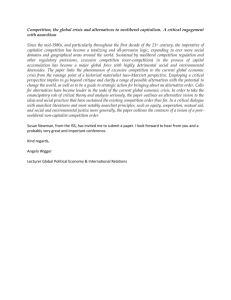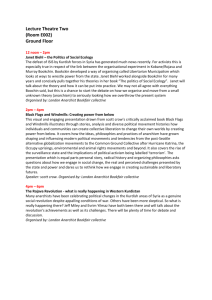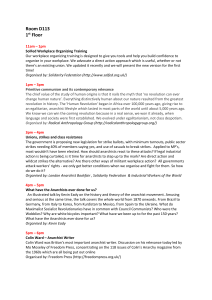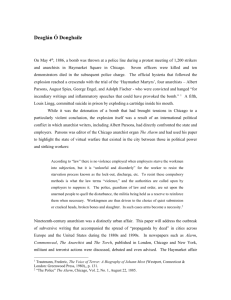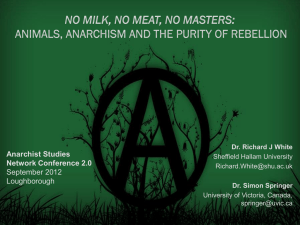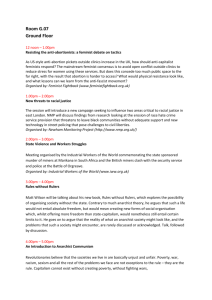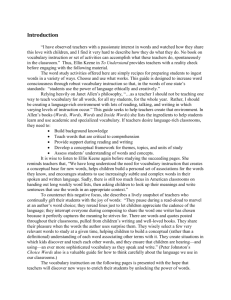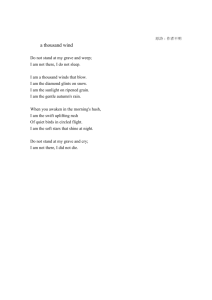Late 19th-Century Images of a Political Phenomenon
advertisement
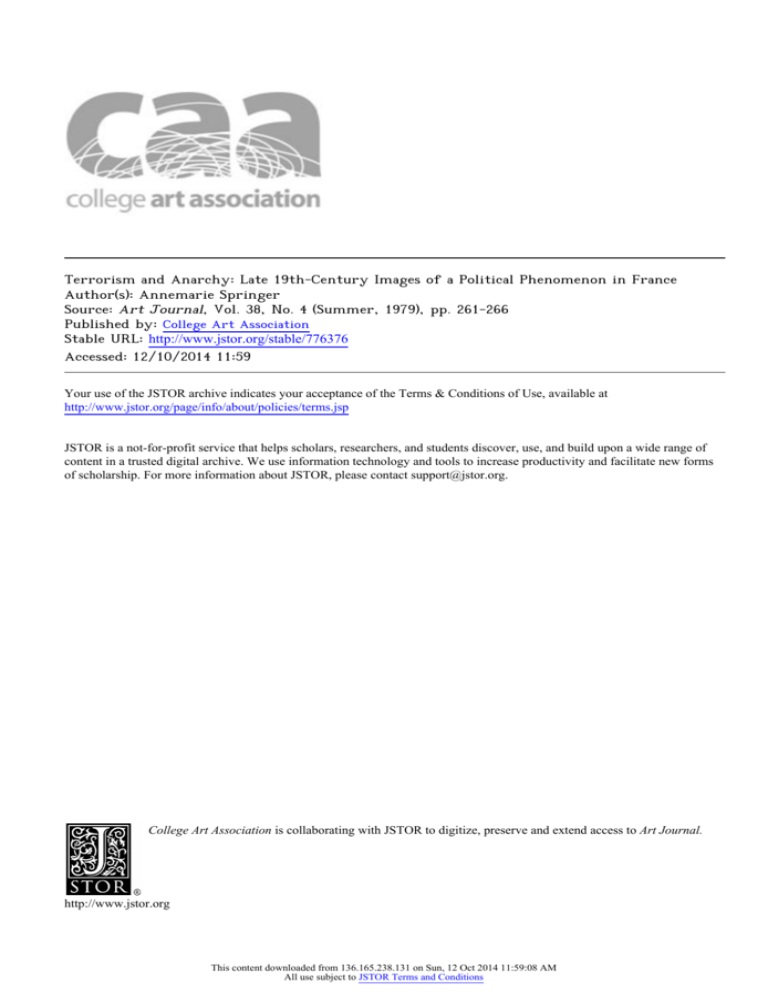
Terrorism and Anarchy: Late 19th-Century Images of a Political Phenomenon in France Author(s): Annemarie Springer Source: Art Journal, Vol. 38, No. 4 (Summer, 1979), pp. 261-266 Published by: College Art Association Stable URL: http://www.jstor.org/stable/776376 . Accessed: 12/10/2014 11:59 Your use of the JSTOR archive indicates your acceptance of the Terms & Conditions of Use, available at . http://www.jstor.org/page/info/about/policies/terms.jsp . JSTOR is a not-for-profit service that helps scholars, researchers, and students discover, use, and build upon a wide range of content in a trusted digital archive. We use information technology and tools to increase productivity and facilitate new forms of scholarship. For more information about JSTOR, please contact support@jstor.org. . College Art Association is collaborating with JSTOR to digitize, preserve and extend access to Art Journal. http://www.jstor.org This content downloaded from 136.165.238.131 on Sun, 12 Oct 2014 11:59:08 AM All use subject to JSTOR Terms and Conditions Terrorismand Anarchy: Late century Images of a Political 19th- in France Phenomenon ANNEMARIE SPRINGER The final decade of the 19th century witnessed a considerable degree of political turmoil in France. The immediate cause of this unrest was the anarchist movement. There were violent murders, bombings, and secret plots. Paris railroad stations and cafes, the Stock Exchange, and the Chamber of Deputies became the targets of terrorist attacks. Yet despite this outburst of violence and death, very few images of terrorism can be found in the visual arts of the 1890s. Only in rare cases did the 19thcentury artist get involved with political extremists. Paul Signac, Camille and Lucien Pissarro, Maximilien Luce, and Theophile-Alexandre Steinlen drew posters, book covers, and illustrations for anarchist publications. Jean Grave, theoretician and unofficial leader of the French anarchist movement, became their friend. Felix Vallotton shared their sympathies in the early 1890s. The intent of this article is to examine the imagery these artists used in their graphics dealing with terror and anarchy. While they were faced with the task of having to transform abstract political concepts such as Oppression, Revolution, Social Awakening, and Liberty into forceful visual messages, they relied upon different iconographical devices. In the examples I have chosen, academic themes based on traditional learning made their appearance alongside contemporary images without any allegory or allusion to earlier art. No judgment can be made today as to the visual impact these graphics had upon contemporary viewers. Their importance lies in the brief involvement of a few French artists with a political phenomenon which is, after all, not unknown to the 20th century. The goals of revolutionary activists of the 1960s and 1970s are in many ways identical to those of the 1890s. The establishment of a society without government has been the "impossible dream" of mankind for centuries. As to the events leading up to the anarchist turmoil in finde-siecle France, they were closely linked to the struggle for social justice in 19th-century Europe. In the generation following the French Revolution, social reformers Fourier and SaintSimon envisioned utopian societies which would eradicate the gulf between wealth and dire poverty caused by the new industrial age. The followers of these two great thinkers did not form active political groups, but their ideas contributed much to the intellectual climate in which the anarchists of the 19th century grew up.' The most influential of these men was the working printer Pierre-Joseph Proudhon, who in 1840 published Qu'est-ce que la Propriete?, in which the answer to the title question of the pamphlet read, "C'est le Vol!"2 This phrase became a powerful revolutionary tool during the second half of the 19th century. Karl Marx came under the spell of Proudhon's quest for social equality, and the Russian Michael Bakunin derived his theory of anarchism from Proudhon's rejection of any kind of authority.3 Both Marx and Bakunin pursued the goal of a classless society and the removal of the State. However, Marx contended that during the period of transition after an initial revolution, the State would have to remain in the form of a dictatorship of the urban proletariat. Bakunin wanted 261 SUMMER 1979 This content downloaded from 136.165.238.131 on Sun, 12 Oct 2014 11:59:08 AM All use subject to JSTOR Terms and Conditions the immediate destruction of all state-, church-, and legal institutions and voiced disgust with Marx's authoritarian methods. "Freedom can only be created by freedom"4 became the battle cry of his anarchist followers. After his death in 1876, Bakunin's influence remained strong in Switzerland, where a compatriot Russian exile, Prince Peter Alexeivitch Kropotkin, actively spread these anarchist ideas to France.5 While in Geneva in 1879, Kropotkin founded a periodical entitled Le RWvolt6,which set the tone for anarchist action later in the century with such inflammatory phrases as "Permanent revolt by word of mouth, in writing, by the dagger, the rifle, dynamite ... everything is good for us which falls outside loyalty."' Two French radical thinkers came under Kropotkin's spell. Elisee Reclus, an internationally known geographer who was exiled after having fought on the barricades of the Commune in 1871, met the Russian anarchist in Geneva. Jean Grave, a typesetter and printer like Proudhon, heard Kropotkin speak in Paris at a Congress of Workers in 1880.7 In 1885 Grave transferred Kropotkin's journal Le Revolte from Geneva to Paris and became the principal spokesman for the anarchist movement in France. With Elis&eReclus as publisher, Grave changed Le Revolte to La Revolte in 1887. In 1894 the journal became known as Les Temps Nouveaux and as such survived until 1914.8 The editorial office was located in a one-room garret on the fifth floor of the rue Mouffetard in a working-class area of Paris, where Jean Grave, dressed in a French worker's long black blouse, lived and worked "simple, silent, indefatigable."9 He printed about 8,000 copies of each weekly issue of La Rdvolte and Les Temps Nouveaux and wrote a number of books on anarchism.10 When the police seized the subscription list of La Revolte in 1894, they found such artists' names as Alphonse Daudet, Anatole France, J.-K. Huysmans, Lecomte de Lisle, and Mallarm.11 This does not mean that these writers and poets -:-:::-:: ::: i: :: ii--i;ii i-ii:;i-::~-: -;-::-: --;?:;?;~i~~-?;-;';--?--;--:;i:-i---iii :lii;;;';"-;iii?ii-.;i-i'--;: ::::--;:-ii-:;-----i;I;_ ;;--...;: .. i' ?Fii?"! ;i ::::i~r -::::: i::.::: :::i-i-::i::i:-:-i:--i-:i~i--iii-~::_:i: :::: ::: ::' :::-::-::: '.;': i;:-:.i;~:ii~~: ~~ ~::;iiiiiiiniiiii-i iii ~~~~_s i~~~ i'; :j: iiii;iii~i-?--iii_-i, " i ;ii I:..i-i sPw"?~:::6:"'c ---. _i-ipi7~8-::i ~li-R'C iii i;~E d ;i:-;i-iiisiiiiis;ii!iii-i _ -iiiiii?iiiiii ii? i:-:----;?-?_ii,-i :--::-?""-i.iii?i;i:-il,?iiiiiii:iii ?l ;:-; ~ c ss~ ;; s'"; i-iis-:::ijiii;ii :;?~, ~TBi ~8h~_:~ i -. i.-- s ::_-?p' ii "" -ii r iY;Yiiiii~i;;-~'~^slli~llsrJI~HI*~-i~.:~ ~~i~-1~IRt~:~ ; i: " ~:::;:~ ii--:~iii- ~:e ii _iii;: -~i--:_ii_ ?iii ;i _:::~~: ~ :s~ ?;i :: ~C ;:-?-I?----: i~~:::~: ii: i: i:-:ii-::::i::::: ; i:,i?ra -:ii-i, i::: ~::i;-::::: i~__ C-~lii:::i-;-::i:::-:_r:~ii:~~::~~_l -::i;l::'--i;:::: -;-:i:::::::i; ;-i--::--: -ii:i;6::i : i ;:-:.__~:: i::::::?::::::: :::g~~W-i~~~~~~ ; :::i ~~i:: .:::: - :: : :;~~:;'-: ::::-''.-.-:::-I--":-----"'--:---aR~~:l :;-:-----~_: ;: Fig. 1. Theophile-Alexandre Steinlen, Evolution et R6volution, lithograph, 1896. were actively involved in terrorist activities. It is the general consensus of authors familiar with French 19th-century politics that anarchism was at no time a "coherent political or philosophical party."12 Jean Maitron believes that in France in the 1890s there were about 1,000 active anarchist militants, 4,500 sympathizers who regularly read anarchist papers, and 10,000 people who were vaguely anarchist in sympathy and prepared to support their aims up to a certain point.13 In general, for the intellectuals in France anarchism "represented an attitude to life rather than a specific theory about society,"14 except for those artists like Camille and Lucien Pissarro, Signac, Luce, and Steinlen, who were closely linked with Jean Grave. For them anarchism was the logical outcome of 19th-century opposition to a hateful bourgeois society. The lithograph Steinlen drew in 1896 for the cover of Elisbe Reclus' anarchist pamphlet Evolution et Revolution (Fig. 1) shows the inside of a dungeon with a barred window. Two men with a crowbar and a third with a pickaxe try to break down the wall. Behind the men there rises the figure of a young woman who holds a flaming torch high above her head. A burst of light surrounds her and illuminates the dark prison cell. The nude torsos of the three men are strong and muscular, their necks are thick, and their arms veined and powerful. They are miners and appear frequently in Steinlen's graphic works. Among the industrial workers of France, the miners were the most dissatisfied group and had staged strikes at predictable intervals since the Second Empire. Emile Zola's novel Germinal, which appeared in serial installments in the Paris journal Gil Bias beginning in November, 1884, is based on an actual 56day strike by 12,000 miners, which had broken out in February of the same year at the Montsou mine at Anzin, in the countryside between Lille and Valenciennes. The themes of revolution and anarchy are very strong throughout the novel, complete with an exiled Russian revolutionary by the name of Souvarine who tells the miners, "lI faut tout detruire, ou la faim repoussera. Oui! L'anarchie, plus rien, la terre lavee par le sang, purifice par I'incendie!"'5 Elisee Reclus does not sound nearly as destructive, and his thesis of "evolution and revolution," which outlines the inevitable development of mankind toward the removal of all inequality between the classes, is couched in a more factual language. He mentions that membership in the International Working Men's Association leads to two years' imprisonment in France. Steinlen's image of the imprisoned workers may therefore be taken as an illustration and indictment of this government policy. On a different level the lithograph must also be regarded as an allegory of Liberation from Oppression or, more specifically, as Revolution by Violence. The allegory is created through the presence of the woman with the torch. Her exact iconographical identification may be difficult to pinpoint. The Republic, Liberty, Revolution, or Anarchy-she belongs to the long line of females personifying some aspect of freedom in 19th-century French art. As a bare-breasted amazon she led the people to glory at the barricades in Eugene Delacroix's 1830 painting La Libertt guidant le Peuple. She became a nourishing and instructing mother-figure in Daumier's oil sketch La Rdpublique in 1848. She shouted encouragement to the volunteers on their way to fight royal oppression in Frangois Rude's monumental 1833 sculptural relief La Marseillaise on the Arc de Triomphe de 262 ART JOURNAL, XXXVlIII/4 This content downloaded from 136.165.238.131 on Sun, 12 Oct 2014 11:59:08 AM All use subject to JSTOR Terms and Conditions 6 Ma L ??Wrwn ll?lw A /a g, oai? I rK, . w4F ?z, FAA Al, im WIF, M R EM, WM Wx 1/0091 I 0A ?lm NO ow me a" F /Z U 21 ING 0. om 7 of, ag 4. T4 Steinlen,La Lib6ratrice,crayondrawing,1903. Fig. 2. Theophile-Alexandre I'Etoile, and in 1878 she called for freedom fighters in Rodin's bronze sculpture La Defense. Her attributes were either a Jacobine cap on her curly head or large wings attached to her back, or a combination thereof. She held a flag or sword; she flew above-or strode mightily alongside-the men under her command. The woman in the prison cell does not closely resemble any one of these preceding images. She rather evokes recollections of F. A. Bertholdi's gigantic statue of Liberty Enlightening the World, which the French sculptor presented to the United States of America in 1884 and which has since become the world's best known symbol of freedom. There is, however, a Steinlen image of Libertywhich is based upon the more standard French 19th-century depictions discussed above. In 1903 the artist sent a crayon drawing to Jean Grave for publication in Les Temps Nouveaux. Entitled La Liberatrice (Fig. 2), this feminine liberator wears both the familiar Jacobine cap and a large pair of wings. In her left hand she holds a broken chain, while her right hand grasps the arm of a man straining upward to be swept to blissful regions of freedom and happiness by her. He is one of a large group of people, most of them working men, lifting their eyes and arms toward this heavenly creature bathed in supernatural light and floating above them. There is indeed an intensely religious fervor in this Steinlen drawing. The winged woman is reminiscent of the angel liberating the apostle Peter in his prison cell in one of the frescoes Pope Julius II commissioned in 1511 from Raphael for his private apartments in the Vatican. It is a phenomenon of 19th-century art that religious and historical themes that had been prominent in the Renaissance and Baroque were transformed to fit new secular subjects. On the whole, 19th-century artists no longer worshiped the saints and heroes of the past. Science and nationalism became their new gods. It is not surprising, therefore, that Steinlen's Spirit of Liberation is endowed with an angel's power of breaking iron shackles and leading a group of workers to a new life of freedom. Steinlen's iconography is quite academic and based upon traditional images. Inflammatory in intent, the lithograph for Evolution et Revolution and the drawing La Liberatrice were nevertheless directed at an audience accustomed to 19th-century historicism. In 1887 Jean Grave had added a literary supplement to his journal, including philosophical, sociological, political, and literary material which was not exactly anarchist in nature but was anti-militaristic, anti-bourgeois, and critical of accepted institutions.16 In 1896 Grave enlisted several artist friends to design frontispieces for the Temps Nouveaux supplement. He collected these lithographs and sold them as an album or one at a time. He also used drawings and paintings for benefit lotteries in the 1890s. Steinlen, Signac, Camille Pissarro, Lucien Pissarro, and Maximilien Luce contributed art works for these events.17 Robert L. and Eugenia W. Herbert have researched the close association of Jean Grave with these French artists during the height of the anarchist movement. The letters they exchanged tell of the sincere desire of these painters to further a cause they so fervently believed in. The question arises whether any event in their personal or artistic background gave the impetus for involvement with anarchism. Steinlen and Vallotton were born in Lausanne, Switzerland, and had been exposed to revolutionary ideas during their formative years. During the 19th century the Swiss Jura region became notorious for its local radical groups, especially those formed by the watchmakers who lived and worked there. After Steinlen and Vallotton had moved to Paris (the former in 1879, the latter in 1882) they continued to feel attracted to the radical elements of French politics. Steinlen had been trained as a painter at the Academie Julian but became known during his long lifetime mainly as an illustrator and social commentator of the Paris urban scene. Vallotton for a few years belonged to the group of Symbolist painters who called themselves Les Nabis. His mastery of the woodcut inspired a revival of this medium among the German Expressionists during the first decade of the 20th century. Camille Pissarro was the oldest member of the group of artists associated with Grave. He had studied the theories of Karl Marx and admired the writings of Kropotkin. One of the originators of Impressionism in the 1870s, he became interested in the Neo-Impressionist painting technique of Seurat in 1885, at which time he made the acquaintance of Paul Signac, who in turn introduced him to Grave.'8 The elder Pissarro instilled Marxist and anarchist ideas in his sons. Lucien Pissarro became especially receptive to them and joined his father as contributor of graphics for the French anarchist cause. Maximilien Luce was born in Paris in 1858. He was thirteen years old at the time of the Commune and never forgot the experience. It led him to a lifetime of devotion to the cause of the poor, the downtrodden, and the exploited. Luce so openly manifested his sympathy for the anarchist movement and for Jean Grave, whom he befriended in 1887, that he was imprisoned for 42 days after the famous trial of 1894 involving 30 radical intellectuals, among them the art critic Felix Feneon and Jean Grave himself.'9 Paul Signac had the closest and longest love affair with anarchism. He lectured to workers and their leaders and stayed close to Jean Grave until well into the second decade of the 20th century. The lithograph which he drew for Grave in 1896, which served as cover and advertising poster for a Temps SUMMER 1979 263 This content downloaded from 136.165.238.131 on Sun, 12 Oct 2014 11:59:08 AM All use subject to JSTOR Terms and Conditions VI 0.1 Ak rp . 74 Noiiiiiiii !:pg oliiiii~i ir *tr tnbv Mip*- Ap 60 4t?i~iiiiiiiii Ngk lp Al -5n A? Ce e- Fig. 4. Paul Signac, Au Temps d'Harmonie,La Joie de Vivre-Dimanche au Bord de la Mer, lithograph, 1895. Fig. 3. Paul Signac, Lithographies,lithograph,1896. Nouveaux album of graphics, features a nude man enveloped in a loosely draped cloth who is slaying a three-headed hydra with an oversize paintbrush (Fig. 3). A close look reveals that the three heads rearing up from the threatening monster are covered with the insignia of the archenemies of anarchists: the Law, the Army, and the Clergy. A priest's round hat with a raised tuft is perched on the lowest serpent's head; the head in the center wears an army officer's cap, and the top head that of a barrister. The clergy and the legal profession had been mercilessly attacked by the great French caricaturist Honore Daumier during the mid-19th century, but Signac's image goes beyond caricature. The viciously snarling monster, whose hairy body and large, ugly claws produce a most unpleasant reaction, embodies the intense revulsion felt by the anarchist artist in dealing with figures of authority. Signac, like Steinlen, relied on academic tradition in formulating his lithograph; the image of the courageous slayer of monsters ultimately derives from the Greek legend of Hercules, who killed the Hydra as part of his twelve labors. Signac has not given him the traditional lion skin and club, and the implied message of the paintbrush serving as weapon makes an active propagandist of the artist. Curiously enough, Signac denied that subject matter was a decisive factor for an anarchist painter.20 His lithographs dealing with workers and peasants in a Garden of Eden setting where ripe fruit can be picked from trees without effort and where laborers may relax by playing ball games, tell of the anarchist dream of Utopia. Such a print, Au Temps d'Harmonie, la Joie de Vivre-Dimanche au Bord de la Mer (Fig. 4) was created by Signac for Les Temps Nouveaux in 1895 but never published by Grave. As a modern version of paradise, Au Temps d'Harmonie is not original and follows the tradition of Impressionist and PostImpressionist paintings depicting outdoor pleasures of a French urban society. Georges Seurat's Sunday Afternoon on the Grande Jatte comes to mind as the supreme example of the happy mixing of old and young, rich and poor, on a day of i~iiiiiiiiiiii!?."Nn iii il li ll i ii ii ii ii ~iii ii iiiiii! ...• iiiiiiill,,•RR : abobM. Fig. 5. Paul Signac, Les Ddmolisseurs,lithograph, 1896. leisure. Paul Signac makes use of such a contemporary theme without harking back to academic art. There are no allusions to mythology in his interpretation of harmony. Since the lithograph also lacks any reference whatever to anarchist political action, it is difficult to imagine it as effective imagery for followers of the cause; perhaps this is why Grave decided against publishing his friend's contribution. A third of Signac's graphics for the anarchist cause, entitled Les Demolisseurs (Fig. 5) appeared in October, 1896 in Les Temps Nouveaux. It is included in this study of imagery because 264 ART JOURNAL, XXXVIII/4 This content downloaded from 136.165.238.131 on Sun, 12 Oct 2014 11:59:08 AM All use subject to JSTOR Terms and Conditions iii:_i 40A%:iii Im~!?i-;i Lc Pe'riIl Aqar~bioste :iiii::iiiii-iiMy'li .1i-- (Owlii i ;i-i-;;;i;--;;;;IT 70 lflustratiuu. et Docue.inets. Fig. 6. LucienPissarro,Tremble,plein-de-truffes,woodcut, 1894. Fig. 7. Anonymous graphic, from Felix Dubois, Le P6ril Anarchiste, 1890s. V it makes use of a contemporary theme in a contemporary idiom like the lithograph Au Temps d'Harmonie. Two men are shown tearing down a city building with axe and crowbar. Iconographically the breaking of stone-whether at the site of a quarry or in the city-implied a glorification of the working man's strength, endurance, and skill in the latter half of the 19th century. Gustave Courbet in his 1849 oil painting The Stonebreakers started this tradition, which placed the farmer as the symbol of honest and hard labor in contrast to the bourgeois who got fat, lazy, and rich on someone else's work. The title of Signac's anarchist print The Demolitioners implies that these two workers were involved in destroying a building, which represents the old, useless structure of the State. Lucien Pissarro portrayed the much-hated bourgeois in a woodcut of 1894 (Fig. 6). The caption Tremble, plein-de-truffes is addressed to the fat, bald man seated in the foreground, who clutches his chest at the vision of a huge crowd approaching from the distance. The crowd's path is lined with gallows from which the dead hang limply. Justice has seemingly been wrought for past and present injuries by the revolutionary crowd marching toward yet another oppressor who feeds on expensive delicacies. This woodcut appeared in November, 1894, in the anarchist bi-weekly Le Ptre Peinard, which was edited by one Emile Pouget and written entirely in tough Paris slang. Pouget had founded the periodical in 1889. He had to flee abroad in 1894 at the time of police harassment of anarchists and sympathizers, but after his return to Paris in 1896, the magazine appeared once more under his leadership.21 Rather than addressing itself to intellectuals and artists like Les Temps Nouveaux, Le Pere Peinard aimed at the working classes. Anti-anarchist books and periodicals in turn addressed themselves to the bourgeoisie, to warn them of impending disaster. The cover for a book by Felix Dubois on the anarchist danger, Le Peril Anarchiste (Fig. 7), shows a member of the bourgeoisie I Nj L *=*I "Ivan Mo -i fel fil, . ... rZ COA . e o., 4 . .. ON tol gelF1 1 1 1 1 1, pi, OR CHF;gM.N. op A IN ",20 0 h. g,.oj ir Wl. 01 g "o " . . al Fig. 8. FelixVallotton,L'Anarchiste,wood engraving,1892. hanging from a tree. The dead man's body is ridiculed and abused by a member of the crowd gathered below. Even without such a book, Parisians had become acutely aware of anarchism since murders and bombings had begun to terrorize them in 1892. The few men behind these acts of violence became, as James Joll states, "legendary and controversial figures in the anarchist movement."22 Felix Vallotton's wood engraving of 1892 shows the arrest of such an anarchist either before or after he committed an act of violence (Fig. 8). Vallotton portrays him as a slight young man who is grabbed by policemen with coarse, threatening faces. Their large, bony hands speak more forcefully of police brutality than their uniforms or sabers. The somewhat romantic attire of the young anarchist-a velvet suit, matching vest, and narrow tie-tell of the artist's attempt to make of him a man imbued with ideals that no longer can be understood by stupid contemporary officials. The moment of arrest is swift and dramatic. SUMMER 1979 265 This content downloaded from 136.165.238.131 on Sun, 12 Oct 2014 11:59:08 AM All use subject to JSTOR Terms and Conditions Vallotton's imagery is that of a photo-reportage, recorded on the scene for a metropolitan public hungry for news. A modern drama in a modern setting! Three of the legendary anarchists who were active in Paris in the 1890s were Ravachol, Vaillant, and Henry. Since Vallotton's wood engraving dates from 1892, it is to be assumed that the anarchist he had in mind was Frangois-Claudius Ravachol, who was executed on July 11, 1892, and in whose honor a ditty with the following refrain circulated in Paris: "Dansonsla Ravachole! Vive le son, vive le son, Dansons la Ravachole, Vive le son de I'Explosion!"23 Ravachol had committed a number of murderous crimes before he came to Paris from the Saint-Etienne area where he was born. He was the first of the Paris bomb throwers and tried to kill several judges, who had sentenced workers taking part in a May Day demonstration in 1891, with a crude, homemade explosive device. Ravachol's arrest took place in a small Paris cafe. The death sentence was imposed for the crimes he had committed previous to the Paris bombing, and it was his insistence that he was involved in them merely to raise money for the anarchist cause that endeared him to adherents of this cause. It is difficult to accept that Vallotton would have made a sensitive, idealistic dreamer of Ravachol, whose criminal nature seems well established. This only reaffirms that the artists sympathetic to anarchism, in their overriding desire to oppose bourgeois values and authority, were oblivious to the reality of terrorism. On the other hand, it may have been wishful thinking on Vallotton's part to confer his personal image of what an anarchist should look like on the fictional person in the wood engraving. Contemporary photographs of Ravachol do not resemble Vallotton's L'Anarchiste in the least. Terrorism and anarchy, as visual images of a political phenomenon at the turn of the century in France, emerge as highly individual dreams of a few artists who hoped for a different world. As such they remain a valuable testimony for the art historian in search of the intricate links between public imagery and private thoughts. U 1. James Joll, TheAnarchists,London,1964, p. 53. 2. AlfredCobban,A Historyof ModernFrance,vol. 2, 1799-1945, Baltimore, 1961, p. 119. 3. TheodoreZeldin,France 1848-1945, vol. 1, Ambition,Love and Politics, Oxford,1973, p. 465. 4. AnthonyMaster,Bakunin,the Fatherof Anarchism,New York,1974, p. xiv. 5. PierreKropotkin,Memoirsof a Revolutionist,London,1899. 6. James Joll, op. cit., p. 127. 7. Jean Grave,Le MouvementLibertairesous la 3* Rdpublique,Paris, 1930, p. 11. 8. Ibid.,p. 18. 9. BarbaraTuchman,TheProudTower,a Portraitof the Worldbeforethe War: 1890-1914, New York,1966, p. 86. 10. EugeniaW. Herbert,The Artistand Social Reformin France and Belgium 1885-1898, New Haven,1961, p. 14. 11. Ibid.,p. 20. 12. James Joll, op. cit., p. 173. 13. Jean Maitron,Histoiredu MouvementAnarchisteen France,Paris,1951, p. 111. 14. James Joll, op. cit., p. 167. 15. EmileZola, Germinal,Paris, 1973, p. 159. 16. EugeniaW. Herbert,op. cit., p. 18. 17. Robert L. and EugeniaW. Herbert,"Artistsand Anarchism:Unpublished Lettersof Pissarro,Signac and Others,"TheBurlingtonMagazine,vol. CII, no. 692, November,1960, p. 482. 18. John Rewald,Post-Impressionism fromVanGoghto Gauguin,2nd ed., New York,1962, p. 155. 19. Exhibitioncatalog, Trdcentenairede Charleroi,MaximilienLuce, Paris, 1966, p. I. 20. RobertL. and EugeniaW. Herbert,op. cit., p. 479. 21. James Joll, op. cit., p. 133. 22. Ibid.,p. 134. 23. Jean Maitron,op. cit., p. 205. AnnemarieSpringerteaches art historyat MountVernonCollege, Washington, D.C. 266 ART JOURNAL, XXXVIII/4 This content downloaded from 136.165.238.131 on Sun, 12 Oct 2014 11:59:08 AM All use subject to JSTOR Terms and Conditions
